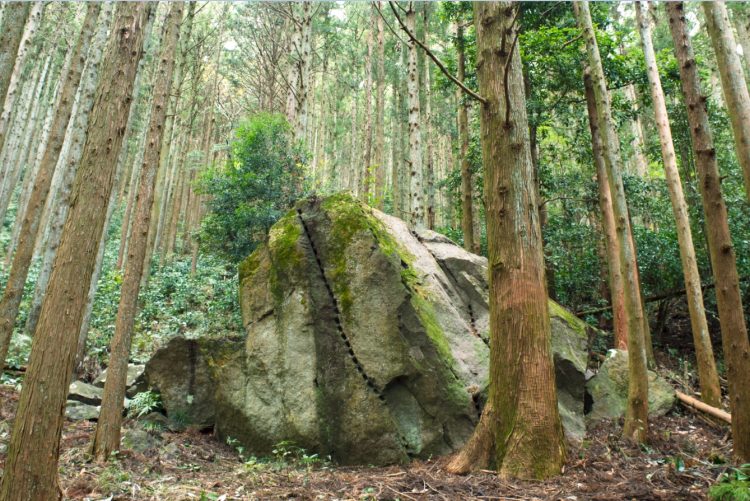Mitake Jinja (Mitake Shrine) and Yasashiba Ishichoba
The stone culture that colored the history of Kanagawa
1. Yasashiba Ishichoba (Yasashiba Stone Quarry)
In the mountains of the Hakone Outer Rim, there were stone cutting locations at each location where stones for the Edo Castle and Odawara Castle walls were quarried. Even now, unfinished stone materials and stones with arrow holes for breaking the stones can be seen in Minamiashigara City, and in the Yasashiba area, is one of the largest that can be presently confirmed. (photo1).
The lava used as stone materials in this area is pyroxene andesite from an eruption 270,000 to 230,000 years ago, and is thought to have originated from Mt. Myojingatake, the outer ring of Hakone volcano.Photo 1 Giant rock with an arrow hole for breaking(Yasashiba district, Minamiashigara city)
Photo 2 Pyroxene andesite
2 Kunoishi (Kuno Stone) (Kamaishi (Kama Stone))
Kuno Stones are distributed in the upstream of the Kuno River in the Kuno Warusawa district of Odawara City. Lapilli tuff or tuff breccia formed by solidifying lapilli, pumice, and volcanic rock fragments, and is believed to be pyroclastic material originating from Myojingatake. It is also called “Kamaishi” in Minamiashigara and Odawara, and was used in warehouses, stone walls, stone stairs, etc., and because of its resistance to fire, it was also used as a material for Kamados (grills) and Shichirin (small stoves).
This stone was also used for the stone steps to worship at Utaki Shrine. (Photo 3)
Photo 3 Stone steps of Mitake Shrine
Photo 4 Kunoishi
The Hakone Volcano started its activity about 400,000 years ago and 230,000 years ago formed several stratovolcanoes. From 230,000 to 130,000 years ago, intense volcanic activity that ejected large amounts of pumice occurred, forming a large caldera in the center of the volcano. After this, volcanic activity continued within the caldera until 130,000 to 80,000 years ago, and lava flowed into the caldera, forming a shield volcano. 80,000 to 60,000 years ago, one of the largest volcanic activities of Hakone Volcano occurred, ejecting large amounts of pumice. The last volcanic activity was repeated in the central part of the caldera from 60,000 to 3,000 years ago, creating the central crater hill.History of the Hakone Volcano
“Stone Exhibition” The stone culture that colored the history of Kanagawa, Kanagawa Prefectural Museum of History (2016) has been re-edited for this page.Regarding the text and photos
“Stone Exhibition” … A special exhibition co-sponsored by the Kanagawa Prefectural Museum of History and the Kanagawa Prefectural Museum of Life and Earth in 2016
Photo 1. From the Kanagawa Prefectural Museum of History
Photo 2.4 From the Kanagawa Prefectural Museum of History
(Photo taken by photographer at the History Museum with the consent of the Kanagawa Prefectural Museum of Life and Earth)
Photo 3. Photo taken by Hakone Geopark Promotion Council




